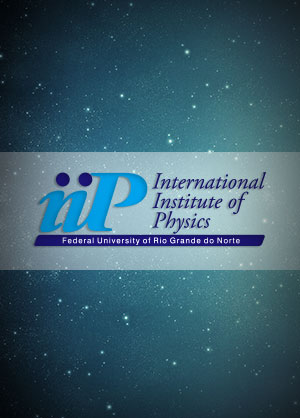Please be aware that the International Institute of Physics, IIP, never contacts the participants to ask for credit card or similar information. Participants are expected to pay for their travel and accommodation by themselves unless they qualify for financial support. If you have any questions, please contact IIP events department at events@iip.ufrn.br
IIP-ICTP School on Gravity and String Theory
Directors:
E. Abdalla, University of São Paulo (São Paulo, Brazil)
J. Maharana, Institute of Physics (Bhubaneswar, India)
P.M. Petropoulos, CPHT, Ecole Polytechnique (Palaiseau, France)
Workshop fees:
Students = USD 85,00 / R$ 150,00
Post docs = USD120,00 / R$ 210,00
Professionals = USD 150,00 / R$ 270,00
April 14th application deadline
Location:
The school will be held at the Auditorium of the Physics Department (DFTE) at the Federal University of Rio Grande do Norte (UFRN) - inside the campus.
The scientific framework
The theme of the event will be String Theoretic Perspectives of Gravitational Processes. Many extensions of the standard model have been proposed since its first experimental confirmations in the early seventies, including supersymmetry, grand unification, and Kaluza–Klein dimensional reduction. Attempts at incorporating gravity within this framework have included supergravity, aiming at merging very-short and very-long distance physics, i.e. cosmology with particle physics. Among these tentative theories of all interactions, the most successful in conceptual terms has been string theory, as it embraces, in a very precise sense, all of them. Although many aspects of string theory still need to be understood, large avenues of research have opened up. These have shed light and have provided tools for understanding a plethora of physical phenomena, such as dualities, new extended objects (D-branes), and the gauge/gravity holographic relation. These tools turned out to be instrumental in e.g. computing microscopically the Bekenstein–Hawking entropy for a class of black holes, exploring the evolution of the universe, or analyzing in a more transparent manner graviton scattering processes, which provide another handle to the structure of quantum gravity effective action. In this perspective, the scientific event will bring together string theorists from within Brazil and from abroad to exchange on several important problems related to the topics mentioned above. Four main axes are foreseen, that correspond to the forefront research in the field:
Black-hole physics
Black-hole physics has raised several puzzles in the past. The most notorious was the microscopic origin of black-hole entropy and its relationship with the black-hole Hawking radiation. Since the seminal work of Strominger and Vafa (1996) the subject has opened up in many directions and is presently a very active branch of research. It involves both physicists and mathematicians since the role of automorphic forms has been of increasing importance in the subject.
Holography and applications
Black-hole physics has also considerably influenced the establishment of the holographic correspondence between gravitational systems in asymptotically anti-de Sitter spaces and conformal field theories defined on the boundaries of these spaces. The AdS/CFT correspondence is an important achievement on its own right that will remain independently of string theory, thanks to its numerous and diverse applications. These aim at unravelling the strong-coupling regimes of a large class of non-gravitational systems of particle physics, fluid dynamics or condensed matter: quark–gluon plasmas, vortices, cold atoms, superconductors . .
Scattering in superstring theories
Considerable attention has been focused on the determination of scattering amplitudes in superstring theories. These theoretical 2 studies yield valuable information about string dynamics and in particular about the structure and properties of the low-energy e active action, constrained by various duality properties. Recently these techniques have enabled us to compute more systematically higher-loop corrections in maximal supergravity theories, demonstrating that their ultraviolet behavior is milder than naively expected. This makes the subject extremely challenging and timely.
String cosmology
The standard model of cosmology accepts the paradigm of inflation but does not provide any theory to explain it out of first principles. Although some interesting proposals have emerged from string theory, this issue is not settled to everyone’s satisfaction. String cosmology continues therefore to be an active area of research, of increasing importance due to the large amount of data that are continuously collected in the various cosmological experiments (WMAP, Planck…). The ultimate goal of these theoretical investigations would be to naturally accommodate inflation and the cosmological constant in a ultraviolet complete theory of gravity, like string theory.
The aim of the meeting is to allow young researchers (students and postdocs) to be exposed to pedagogical lectures at the cutting edge of the field, by senior physicists from abroad and from Brazil, and provide the appropriate environment for scientific collaboration. Besides the courses, topical seminars will be organized for the benefit of all participants allowing for wider discussion sessions among experts of string theory. Our intention is to avoid overloading the program, but instead leaving time for discussions that might also, when appropriate and demanded, be of tutorial type.
This school will be preceeded by a two-day informal workshop from May 08-09 to be held at the ICTP-SAIFR in the auditorium of IFT-UNESP.









